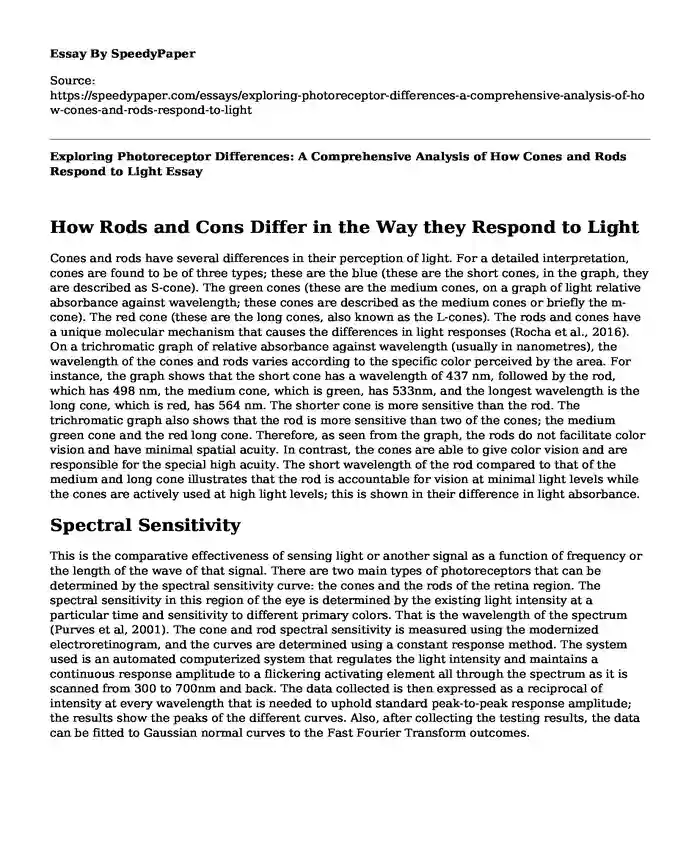
| Essay type: | Compare and contrast |
| Categories: | Technology Electronics |
| Pages: | 3 |
| Wordcount: | 755 words |
How Rods and Cons Differ in the Way they Respond to Light
Cones and rods have several differences in their perception of light. For a detailed interpretation, cones are found to be of three types; these are the blue (these are the short cones, in the graph, they are described as S-cone). The green cones (these are the medium cones, on a graph of light relative absorbance against wavelength; these cones are described as the medium cones or briefly the m-cone). The red cone (these are the long cones, also known as the L-cones). The rods and cones have a unique molecular mechanism that causes the differences in light responses (Rocha et al., 2016). On a trichromatic graph of relative absorbance against wavelength (usually in nanometres), the wavelength of the cones and rods varies according to the specific color perceived by the area. For instance, the graph shows that the short cone has a wavelength of 437 nm, followed by the rod, which has 498 nm, the medium cone, which is green, has 533nm, and the longest wavelength is the long cone, which is red, has 564 nm. The shorter cone is more sensitive than the rod. The trichromatic graph also shows that the rod is more sensitive than two of the cones; the medium green cone and the red long cone. Therefore, as seen from the graph, the rods do not facilitate color vision and have minimal spatial acuity. In contrast, the cones are able to give color vision and are responsible for the special high acuity. The short wavelength of the rod compared to that of the medium and long cone illustrates that the rod is accountable for vision at minimal light levels while the cones are actively used at high light levels; this is shown in their difference in light absorbance.
Spectral Sensitivity
This is the comparative effectiveness of sensing light or another signal as a function of frequency or the length of the wave of that signal. There are two main types of photoreceptors that can be determined by the spectral sensitivity curve: the cones and the rods of the retina region. The spectral sensitivity in this region of the eye is determined by the existing light intensity at a particular time and sensitivity to different primary colors. That is the wavelength of the spectrum (Purves et al, 2001). The cone and rod spectral sensitivity is measured using the modernized electroretinogram, and the curves are determined using a constant response method. The system used is an automated computerized system that regulates the light intensity and maintains a continuous response amplitude to a flickering activating element all through the spectrum as it is scanned from 300 to 700nm and back. The data collected is then expressed as a reciprocal of intensity at every wavelength that is needed to uphold standard peak-to-peak response amplitude; the results show the peaks of the different curves. Also, after collecting the testing results, the data can be fitted to Gaussian normal curves to the Fast Fourier Transform outcomes.
Pigment Absorption Spectra
The molecules found in the eye that are responsible for light detection and absorption are called pigments, the set of wavelengths of light that is absorbed by the pigments is referred to as the pigment’s absorption spectrum. Albeit the absorption spectrum of rods is the same shape as the spectra of cones when expressed on a graph, the rods are very sensitive compared to cones; they also show a more stronger response to light than cones. Comparatively, all rods have similar spectral absorption and sensitivity; therefore, one cannot compare the different rods since they work under low light sensitivity (Berg et al., 1970). Cones have three different types that are distinguished by their pigmentation. They range from those that can absorb different wavelengths of light, such as short, long, and medium wavelengths.
References
Berg, J. M., Tymoczko, J. L., & Stryer, L. (1970). Photoreceptor Molecules in the Eye Detect Visible Light. Current Neurology and Neuroscience Reports.https://www.ncbi.nlm.nih.gov/books/NBK22541/https://journals.plos.org/plosone/article?id=10.1371/journal.pone.0147318https://www.ncbi.nlm.nih.gov/books/NBK11059/
Purves, D., Augustine, G. J., Fitzpatrick, D., Katz, L. C., LaMantia, A. S., McNamara, J. O., & Williams, S. M. (2001). Cones and color vision. Neuroscience. 2nd edition. Sunderland (MA): Sinauer Associates.
Rocha, F. A. D. F., Gomes, B. D., Silveira, L. C. D. L., Martins, S. L., Aguiar, R. G., de Souza, J. M., & Ventura, D. F. (2016). Spectral sensitivity measured with electroretinogram using a constant response method. PloS one, 11(1), e0147318.
Cite this page
Exploring Photoreceptor Differences: A Comprehensive Analysis of How Cones and Rods Respond to Light. (2023, Dec 06). Retrieved from https://speedypaper.net/essays/exploring-photoreceptor-differences-a-comprehensive-analysis-of-how-cones-and-rods-respond-to-light
Request Removal
If you are the original author of this essay and no longer wish to have it published on the SpeedyPaper website, please click below to request its removal:
- Cyber Crimes Essay Sample
- Essay Example: Comparative Analysis of Access and SQL Databases
- Ethical Issues in Information Technology, Essay Example
- Essay Sample: Congress Launches Caucus on AI
- Why Telecom Companies Need Big Data - Argumentative Essay Sample
- Free Essay Sample - Background to the Business
- Tech Revolution in Education: Unlocking New Possibilities for Learning - Essay Sample
Popular categories




